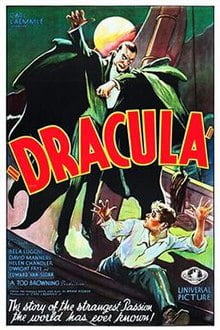The story of the strangest Passion the world has ever known!
Transylvanian vampire Count Dracula bends a naive real estate agent to his will, then takes up residence at a London estate where he sleeps in his coffin by day and searches for potential victims by night.
Dracula (1931) is a horror film directed by Tod Browning, based on the novel of the same name by Bram Stoker. The movie tells the story of Count Dracula, a centuries-old vampire who travels from his castle in Transylvania to London, where he preys upon young women to satiate his thirst for blood. The film is considered a classic of the horror genre and helped establish many of the conventions of vampire movies that are still in use today.
One of the most striking aspects of the film is the performance of Bela Lugosi in the titular role. Lugosi’s portrayal of Dracula has become iconic, with his distinctive accent, piercing stare, and hypnotic presence making him a memorable and terrifying villain. The film’s other cast members, including Helen Chandler as Mina Harker and Dwight Frye as Renfield, also deliver strong performances, adding to the movie’s overall impact.
The cinematography in Dracula (1931) is another standout feature. The movie makes great use of shadows and lighting to create an atmosphere of gothic horror, with the scenes set in Dracula’s castle being particularly effective in establishing a sense of dread and unease. The film’s art direction and set design also contribute to the movie’s overall aesthetic, with the use of medieval and Victorian motifs helping to create a timeless sense of terror.
Despite its age, Dracula (1931) remains a highly effective horror movie. While it may lack some of the more visceral scares of contemporary horror films, it still manages to create a sense of unease and tension through its atmosphere and pacing. The film’s influence on the horror genre cannot be overstated, with many subsequent vampire movies owing a debt to the conventions established in this classic film.
However, it is worth noting that Dracula (1931) does suffer from some of the limitations of early cinema. The movie’s pacing can feel slow at times, and the lack of special effects can make some of the film’s supernatural elements seem less convincing than they might in a more modern movie. Additionally, some viewers may find the movie’s portrayal of women and people of color to be problematic, reflecting the biases and prejudices of the time in which the film was made.
In conclusion, Dracula (1931) is a classic horror movie that has stood the test of time. It may not be as visually stunning or fast-paced as contemporary horror films, but its atmospheric style and iconic performances still make it a compelling watch for horror fans. The film’s impact on the genre cannot be overstated, and it remains an essential entry in any list of classic horror movies.


 Buy me a coffee
Buy me a coffee